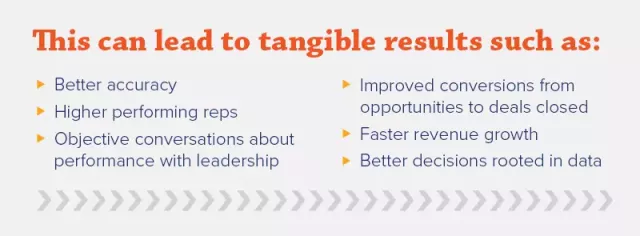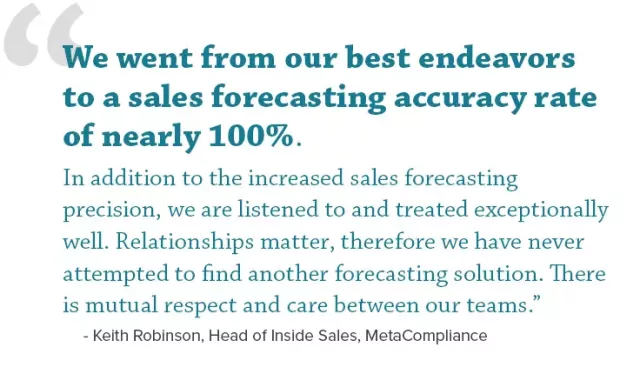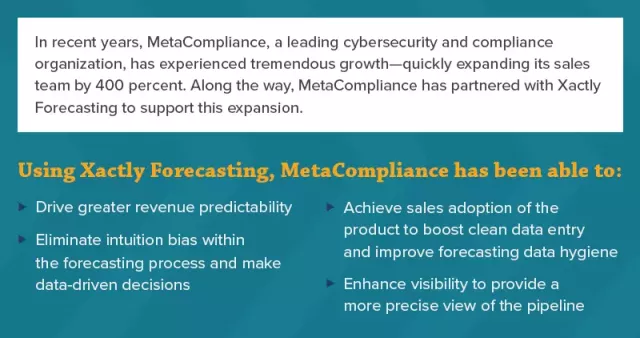
Gaining Competitive Intelligence via Accurate Sales Forecasting
When forecasting is done correctly, your company can make informed decisions to improve both short- and long-term performance. That's why leadership relies so heavily on these numbers to carry them into the next year.
Think about it: when you promise your executive leadership something, and you don’t deliver, what happens?
“You missed the number? Hey, no problem! you’ll get it next quarter!”
News flash: you will NEVER hear that from anyone in a leadership position.
To avoid that situation, you need to have confidence in your numbers (which current data shows 55 percent of current leaders do not have)1. The difference between success and failure when predicting revenue targets and creating sales plans all comes down to one thing: data.
Let’s take a quick look at what access to accurate and reliable data can do for your enterprise.
Before Data
The days before revenue forecasts are due are often long and frantic because the data needed is either lost in communication silos or contained in multiple manual systems.
Leaders are being challenged to be more flexible and adaptable than ever—yet they are held back by their current solutions. And what is this current solution? No solution. Leaders are basing their decisions and projections based on limited information and gut feeling.
Four problems accompany this all-too-common scenario:
- Inefficient processes: 67 percent of companies don't have a formalized approach to forecasting2. That not only leaves room for error, but it also opens up your organization to possible lost profit.
- Inaccurate data: After the data is organized, you can't guarantee it's accurate, especially when research shows that 80 percent of spreadsheets contain errors3.
- Misaligned sales planning: Because your sales and finance teams are gathering data from multiple sources, there's no data consistency. Not only will your forecasting and planning be misaligned from the start, but you'll also be unable to adjust proactively or identify major problems until after they have already wreaked havoc.
- Time-consuming: Manual forecasting is quite a long process. The longer you spend working on sales forecasting, the higher the possibility of losing actual sales opportunities. Time is money!
Long Term Problem:
As of right now, 80 percent of sales enterprises do not have a forecast accuracy of greater than 75 percent4. Why? Because they lack the strategy and data needed to create organizational alliance and confidence around plans.
Unfortunately, the Xactly State of Global Enterprise Sales Performance survey found that “gut instinct” was the second most common decision-making factor for leaders behind “doing things the way they’ve always been done.” Those two approaches account for how 53 percent of organizations handle internal decision-making.
Accurate forecasting is critical, but it's nearly impossible when it's based on guesswork, assumptions, and gut feelings. If you can’t trust your data, you are limited in your ability to pivot with agility, anticipate new challenges, and recover successfully when market disruptions occur.
That poses a huge threat to today’s business leaders. If they rely too heavily on their intuition, it can be dangerously unreliable in complicated situations. There is a more rational approach to making business decisions—data and analysis.
After Data
Data and insight analytics have long been associated with informed decision-making because they reduce the likelihood of errors. When your company has a single source of data, or truth as we call it, you have all the information you need to make real-time strategic decisions.
Long Term Solution:
Using data and Artificial Intelligence (AI) to make informed business decisions improves sales performance across the board. This can reduce risk, contain costs, and create revenue stability.
According to research from the Aberdeen Group5, businesses that produce accurate demand and sales forecasts are 7.3 percent more likely to hit their quotas and 10 percent more likely to make improvements to their bottom line.
A clear understanding of the quality of your sales data is the first step towards unlocking reliable, predictable, and resilient revenue. By using intelligent forecasting methods, you can spot potential problems early on, identify new opportunities that previously weren’t visible, utilize guided selling to improve coaching, and gain insights around your sales cycle.
Why Accurate Data and Reliable Software is Make-It or Break-It for Organizations
Good data is the most important requirement for a good sales projection. Here are four areas of sales forecasting that an intelligent solution improves:
1. Documenting Your Sales Processes
A sales process is a defined series of steps you follow as you guide prospects from initial contact to purchase. By formalizing and documenting this process, you can increase your visibility into how potential customers buy your product. This helps to improve sales performance and grow revenue.
2. Calling Your Numbers and Setting Quota
Too often, companies allocate quotas based on the numbers they want to hit. Having detailed and historical insight into your quota attainment patterns is vital to setting reasonable sales targets.
Set quotas too high, motivation and performance plummets. Set them too low, and again, you see the same thing, lower effort and performance from the salesforce. At the end of the day, hitting the sweet spot and nailing your numbers is the most important thing for companies trying to create sustainable growth.
3. Benchmarking Sales Metrics
Sales tracking and benchmarking allows organizations to measure and monitor every aspect of performance. Almost everything that a sales rep does can be tracked, quantified, and measured. Leadership can use those insights to create data-driven plans, determine what works and what doesn't, and make changes to boost revenue for the business.
4. Understanding Your Sales Pipeline
Effective pipeline management allows salespeople to keep track of deals by knowing exactly which stage each deal is in and whether there are enough deals on the board to hit your goals. Mastering your pipeline is an extremely effective way to increase revenue because it allows sales reps to remain organized and focused on selling.
Forecasting For The Future
Combining access to rich data with an intelligent forecasting solution is a winning combination when it comes to predicting accurate and reliable revenue numbers. This, in turn, helps to inform business decisions, such as expenses, growth initiatives, and resource allocation.
But don't just take our word for it. Learn how investing in intelligent forecasting software helped our customer MetaCompliance not only hit but exceed their revenue goals.
Think of your forecast as the roadmap your organization should follow turn-by-turn in order to reach a successful fiscal year.
Forecasts should include your estimated sales performance, revenue, and resources that will serve as your organization’s GPS in the planning processes. This requires accurate and real-time data to avoid missing any turns or route recalculations that might pop up throughout the trip. With more confidence in data accuracy, companies can use their sales data to forecast accurately and strategically.
To learn more about how accurate forecasting can positively impact your bottom line, check out our guide, “Why a RevOps Mindset Depends on Accurate Sales Forecasting”.
Sources:






